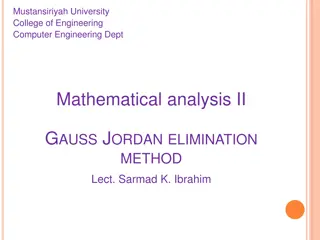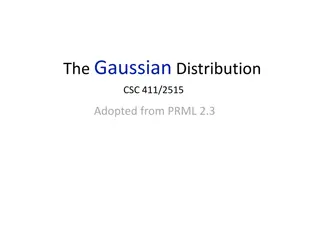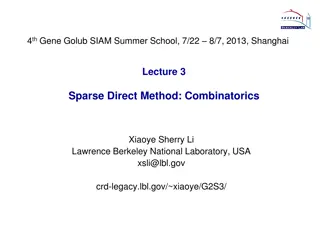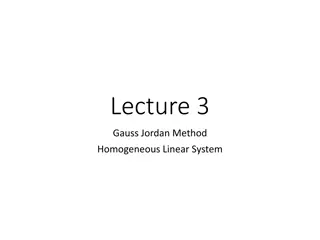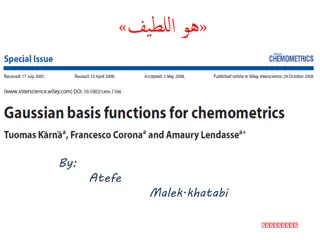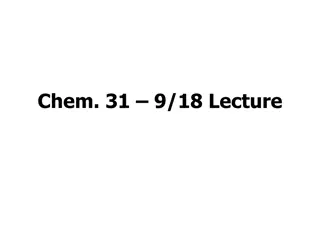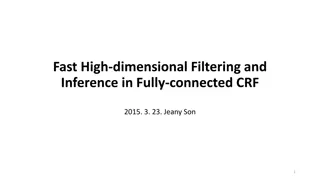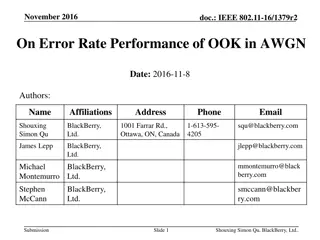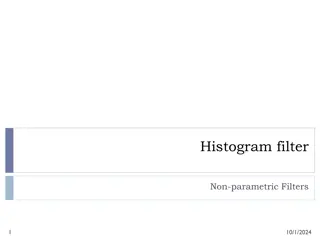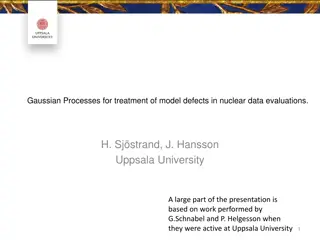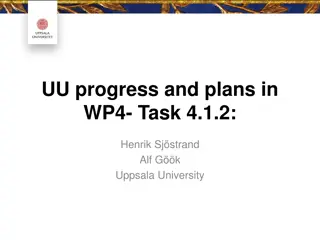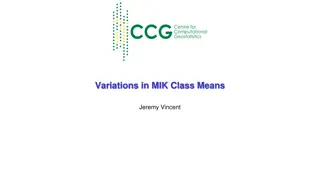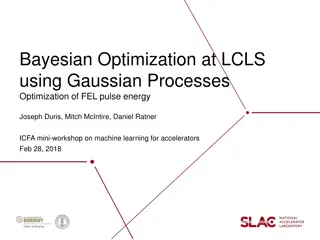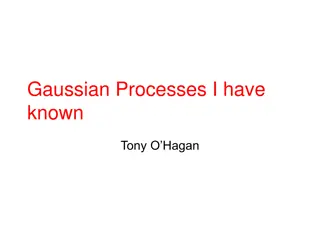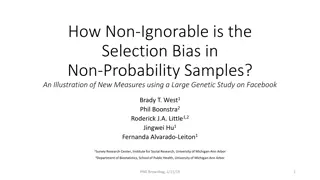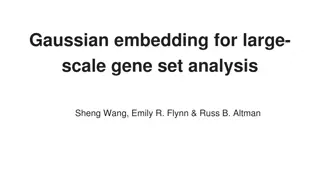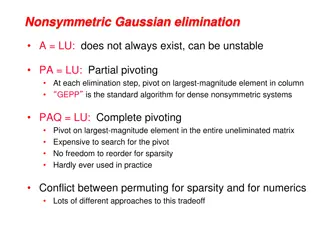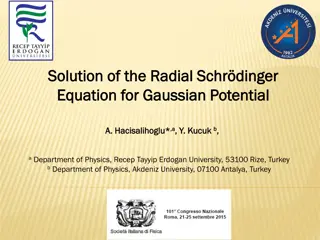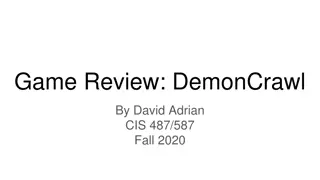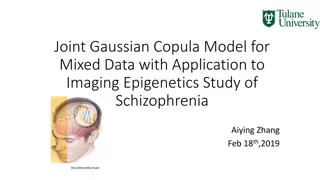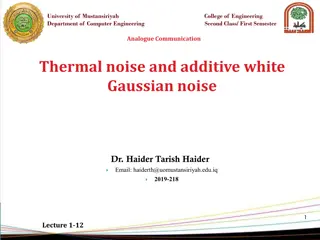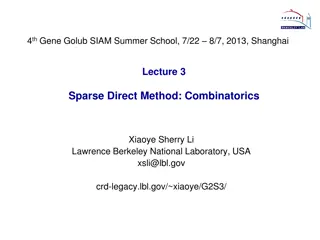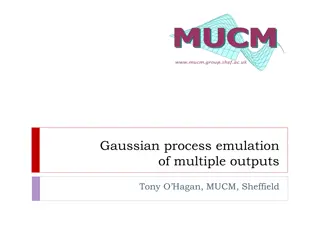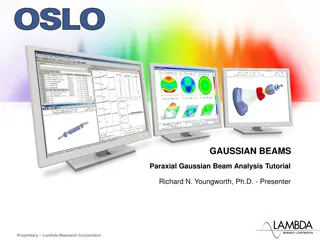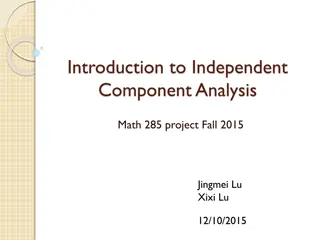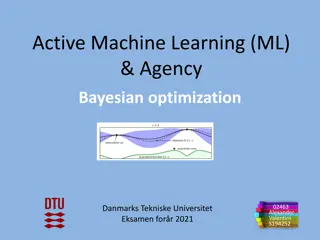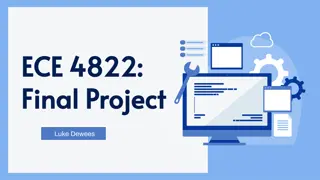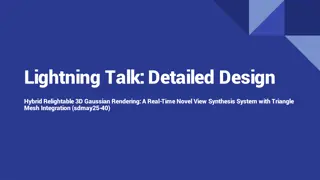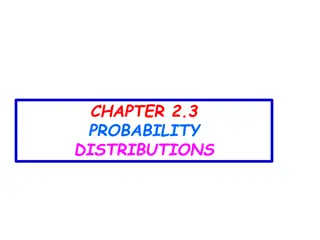Unraveling the Gaussian Copula Model and the Financial Collapse of 2008
Explore the dangers of relying on the Gaussian copula model for pricing risks in the financial world, leading to the catastrophic collapse of 2008. Discover how the lure of profits overshadowed warnings about the model's limitations, causing trillions of dollars in losses and threatening the global
7 views • 18 slides
Gaussian Elimination Method in Linear Algebra
Gaussian Elimination and Gauss-Jordan Elimination are methods used in linear algebra to transform matrices into reduced row echelon form. Wilhelm Jordan and Clasen independently described Gauss-Jordan elimination in 1887. The process involves converting equations into augmented matrices, performing
5 views • 14 slides
The Gaussian Distribution and Its Properties
This insightful content dives into the Gaussian Distribution, including its formulation for multidimensional vectors, properties, conditional laws, and examples. Explore topics like Mahalanobis distance, covariance matrix, elliptical surfaces, and the Gaussian distribution as a Gaussian function. Di
0 views • 19 slides
Overview of Sparse Linear Solvers and Gaussian Elimination
Exploring Sparse Linear Solvers and Gaussian Elimination methods in solving systems of linear equations, emphasizing strategies, numerical stability considerations, and the unique approach of Sparse Gaussian Elimination. Topics include iterative and direct methods, factorization, matrix-vector multi
0 views • 35 slides
Gaussian Elimination and Homogeneous Linear Systems
Gaussian Elimination is a powerful method used to solve systems of linear equations. It involves transforming augmented matrices through row operations to simplify and find solutions. Homogeneous linear systems have consistent solutions, including the trivial solution. This method is essential in li
0 views • 16 slides
Functional Approximation Using Gaussian Basis Functions for Dimensionality Reduction
This paper proposes a method for dimensionality reduction based on functional approximation using Gaussian basis functions. Nonlinear Gauss weights are utilized to train a least squares support vector machine (LS-SVM) model, with further variable selection using forward-backward methodology. The met
0 views • 23 slides
Gaussian Statistics and Confidence Intervals in Population Sampling
Explore Gaussian statistics in population sampling scenarios, understanding Z-based limit testing and confidence intervals. Learn about statistical tests such as F-tests and t-tests through practical examples like fish weight and cholesterol level measurements. Master the calculation of confidence i
0 views • 8 slides
Fast High-Dimensional Filtering and Inference in Fully-Connected CRF
This work discusses fast high-dimensional filtering techniques in Fully-Connected Conditional Random Fields (CRF) through methods like Gaussian filtering, bilateral filtering, and the use of permutohedral lattice. It explores efficient inference in CRFs with Gaussian edge potentials and accelerated
1 views • 25 slides
Advanced Emission Line Pipeline for Stellar Kinematics Analysis
This comprehensive pipeline includes processes for stellar kinematics, continuum fitting, Gaussian line fitting, and analysis of SAMI-like cubes. It also covers Gaussian fitting techniques, parameter mapping, and potential issues. The pipeline features detailed steps and strategies for accurate anal
0 views • 10 slides
Error Rate Performance of OOK Modulation in AWGN Channels
This document discusses the error rate performance of On-off keying (OOK) modulation in Additive White Gaussian Noise (AWGN) channels, covering both coherent and non-coherent detection methods. The theoretical results and evaluations of OOK modulation in AWGN are reviewed, providing insights into op
0 views • 17 slides
Robot Localization Using Kalman Filters
Robot localization in a hallway is achieved through Kalman-like filters that use sensor data to estimate the robot's position based on a map of the environment. This process involves incorporating measurements, updating state estimates, and relying on Gaussian assumptions for accuracy. The robot's u
1 views • 26 slides
Statistical Distributions in Physics
Exploring the connections between binomial, Poisson, and Gaussian distributions, this material delves into probabilities, change of variables, and cumulative distribution functions within the context of experimental methods in nuclear, particle, and astro physics. Gain insights into key concepts, su
0 views • 13 slides
Gaussian Processes for Treatment of Model Defects in Nuclear Data Evaluations
Gaussian Processes (GP) are explored for treating model defects in nuclear data evaluations. The presentation discusses the impact of model defects on evaluation results and proposes using GP to address these issues. The concept of GP and its application in treating model defects are detailed, highl
2 views • 28 slides
Enhancing Nuclear Data Evaluation with Gaussian Processes
Uppsala University is investing efforts in developing the TENDL methodology to incorporate model defect methods for nuclear data evaluations. By leveraging Gaussian Processes and Levenberg-Marquardt algorithm, they aim to improve the accuracy and reliability of calibration data to produce justified
0 views • 16 slides
Analyzing Variations in MIK Class Means by Jeremy Vincent
The presentation delves into the MIK estimator, exploring its impact on estimation with constant class means and non-Gaussian data. Review of initial results, examination of class mean bias in upper tail, and implications for metal containment are discussed. Cross-validation study findings, future w
1 views • 9 slides
Bayesian Optimization at LCLS Using Gaussian Processes
Bayesian optimization is being used at LCLS to tune the Free Electron Laser (FEL) pulse energy efficiently. The current approach involves a tradeoff between human optimization and numerical optimization methods, with Gaussian processes providing a probabilistic model for tuning strategies. Prior mea
1 views • 16 slides
Gaussian Processes: A Comprehensive Overview
Gaussian Processes (GPs) have wide applications in statistics and machine learning, encompassing regression, spatial interpolation, uncertainty quantification, and more. This content delves into the nature of GPs, their use in different communities, modeling mean and covariance, as well as the nuanc
0 views • 50 slides
Reservoir Modeling Using Gaussian Mixture Models
In the field of reservoir modeling, Gaussian mixture models offer a powerful approach to estimating rock properties such as porosity, sand/clay content, and saturations using seismic data. This analytical solution of the Bayesian linear inverse problem provides insights into modeling reservoir prope
0 views • 10 slides
How Non-Ignorable is the Selection Bias in Non-Probability Samples?
Big Data often derive from non-probability samples, necessitating model-based approaches for inference. Tools to gauge non-ignorable selection bias in descriptive estimates from such samples are lacking. This work aims to address this gap by developing new measures. Building on previous work, the st
0 views • 27 slides
Gaussian Embedding for Large-Scale Gene Set Analysis
Gene sets in various downstream analyses such as disease signature identification, drug pathway association, survival analysis, and drug response prediction come from diverse sources and play a crucial role in boosting the signal-to-noise ratio. Gaussian embedding is utilized to model uncertainty, p
0 views • 14 slides
Nonsymmetric Gaussian elimination
Intricacies of nonsymmetric Gaussian elimination, LU factorization, partial pivoting, left-looking column LU factorization, symbolic sparse Gaussian elimination, column preordering for sparsity, and more in numerical linear algebra algorithms.
0 views • 28 slides
Gaussian Processes to Speed up Hamiltonian Monte Carlo
Bayesian inference, Metropolis-Hastings, Hamiltonian Monte Carlo, and Markov Chain Monte Carlo are explored in the context of sampling techniques and estimation of probability distributions in complex models. The use of Gaussian processes to enhance the efficiency of Hamiltonian Monte Carlo is discu
0 views • 14 slides
Radial Schrödinger Equation Solution for Gaussian Potential
Energy eigenvalues and eigenfunctions in quantum mechanics are studied through the exact solution of the radial Schrödinger equation for Gaussian potentials, using the Asymptotic Iteration Method. The method's efficiency in solving wave equations for different potentials is highlighted, with a focu
0 views • 23 slides
Estimates of Mean and Errors in Gaussian Distribution
In Chapter 4, the method of least squares for estimating the mean in Gaussian distribution is discussed using the method of maximum likelihood. The concept is explained through equations detailing the probability function and calculation of the most probable value for the mean.
0 views • 9 slides
Seminar presentation
This project focuses on developing a robot-assisted steady ultrasound imaging system using deep learning techniques. The aim is to address challenges in imaging real tissue with non-random scatterer configurations, where traditional models may fall short. By employing Gaussian Process and motion est
0 views • 21 slides
Applied statistics
Delve into the fundamental principles of applied statistics, covering topics such as expected value, variance of random variables, correlation coefficients, and Pearson correlation. Explore the significance of correlations between variables and the interpretation of correlation values. Learn about s
0 views • 14 slides
Joint Gaussian Copula Model for Mixed Data with Application to Imaging Epigenetics Study of Schizophrenia
Schizophrenia (SZ) is a chronic and severe mental disorder characterized by hallucinations, delusions, cognitive dysfunction, and disrupted brain connectivity. This study explores the use of a Joint Gaussian Copula Model to analyze mixed data types, combining molecular to organ levels, providing new
0 views • 14 slides
Analogue Communication: Thermal Noise and Additive White Gaussian Noise Lecture Series
Explore the world of analogue communication with a focus on thermal noise and additive white Gaussian noise in this lecture series by Dr. Haider Tarish Haider at the University of Mustansiriyah. Dive into the fundamentals of communication theory with informative slides and engage in a Q&A session fo
0 views • 10 slides
Sparse Linear Solvers: Strategies and Gaussian Elimination Overview
Explore the concepts of sparse linear solvers, including strategies for solving systems of linear equations with many zeros, the distinction between direct and iterative methods, and an overview of Gaussian Elimination for numerical stability. Gain insights into the algorithms, techniques, and consi
0 views • 35 slides
Gaussian Process Emulation of Multiple Outputs: Overview and Best Practices
Understand Gaussian process emulators for multiple outputs, including simulators, GP modeling, mean functions, and covariance functions. Learn how to validate and optimize the emulator effectively.
0 views • 17 slides
Gaussian Processes: Understanding Nonparametric Regression
Learn about Gaussian processes and their use in nonparametric regression, exploring concepts like multivariate normal distributions, covariance matrices, and Bayesian parameter estimation. Gain insights into the advantages and applications of Gaussian distributions in modeling complex data.
1 views • 30 slides
Gaussian Mixture Model and EM Recitation Overview
Explore the concepts of Gaussian Mixture Model (GMM) and Expectation Maximization (EM) through recitation slides covering motivation, formulation, definitions, and detailed steps of EM algorithm. Understand how GMM works as a distribution and dive into the intricacies of EM for inference and learnin
0 views • 14 slides
Paraxial Gaussian Beam Analysis Tutorial with OSLO Software
Explore paraxial analysis of Gaussian beams using OSLO software for optical layout in laser systems. Learn theory, system setup, beam tracing, and more. Extensive capabilities beyond basics covered in this tutorial. Images and step-by-step instructions included.
0 views • 16 slides
Introduction to Independent Component Analysis in Math
Explore the concept of Independent Component Analysis (ICA) in this informative project presentation. Learn about the Cocktail Party Problem, ICA model, Fast ICA algorithm, and more. Discover the motivation behind ICA and the process of estimating original speech signals. Understand the principles a
0 views • 23 slides
Agency Bayesian Optimization with Gaussian Processes
Explore the role of covariance functions in Gaussian processes for active machine learning and agency applications. Understand how kernel functions create covariance matrices, influencing the distribution of function values. Learn about smoothness assumptions, signal variance, noise variance, and mo
0 views • 49 slides
Efficient GPU-Accelerated Gaussian Filter Implementation for Image Processing
Explore the optimization of a GPU-accelerated Gaussian filter implementation for image processing, focusing on library usage, preprocessing strategies, GPU kernel design, timing results, and proposed improvements for enhanced performance.
0 views • 10 slides
Real-Time Novel View Synthesis System with 3D Gaussian Rendering
Explore a cutting-edge system using 3D Gaussian splats and raytracing for dynamic lighting and mesh integration. Leveraging machine learning and Unity, this project aims to generate new scene images under varied lighting conditions seamlessly.
0 views • 8 slides
Gaussian Distribution: Characteristics and Derivations
Explore the Gaussian distribution, an approximation of the binomial and Poisson distributions, exhibiting a bell-shaped curve with characteristics like mean estimation and probability density function. Learn about the continuous nature, interval definition, and full-width at half maximum of the Gaus
0 views • 25 slides
Sparse Ax=b Solvers and Cholesky Factorization
Discover the landscape of sparse Ax=b solvers, from direct solvers like LU to iterative methods such as GMRES and QMR. Explore Cholesky factorization techniques, including both general and sparse column approaches. Learn about sparse Gaussian elimination, Chordal completion, and the Cholesky graph g
0 views • 21 slides
Scalar Theory of Diffraction in Optics: Understanding Gaussian Beams
Explore the scalar theory of diffraction in optics with a focus on Gaussian beams, including discussions on phase terms, power calculations, and direct vs. inverse problems. Learn from Andrea Fratalocchi's insightful EE231 Introduction to Optics slides.
0 views • 24 slides

